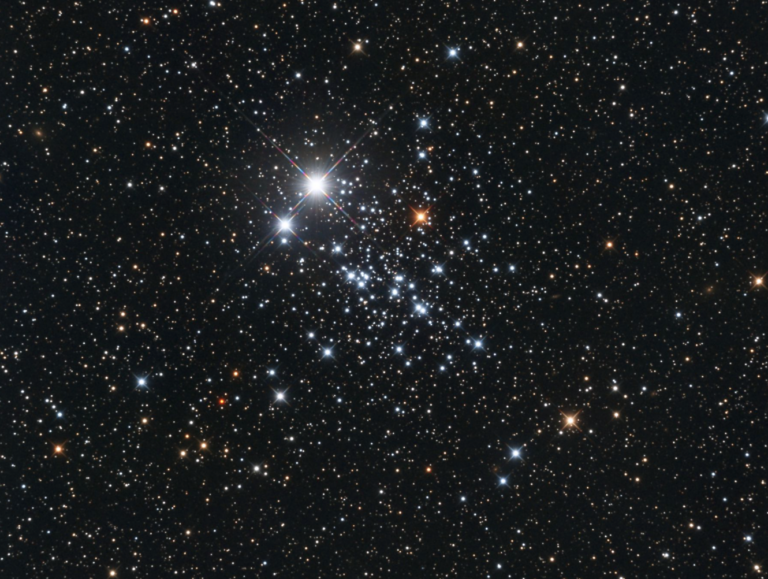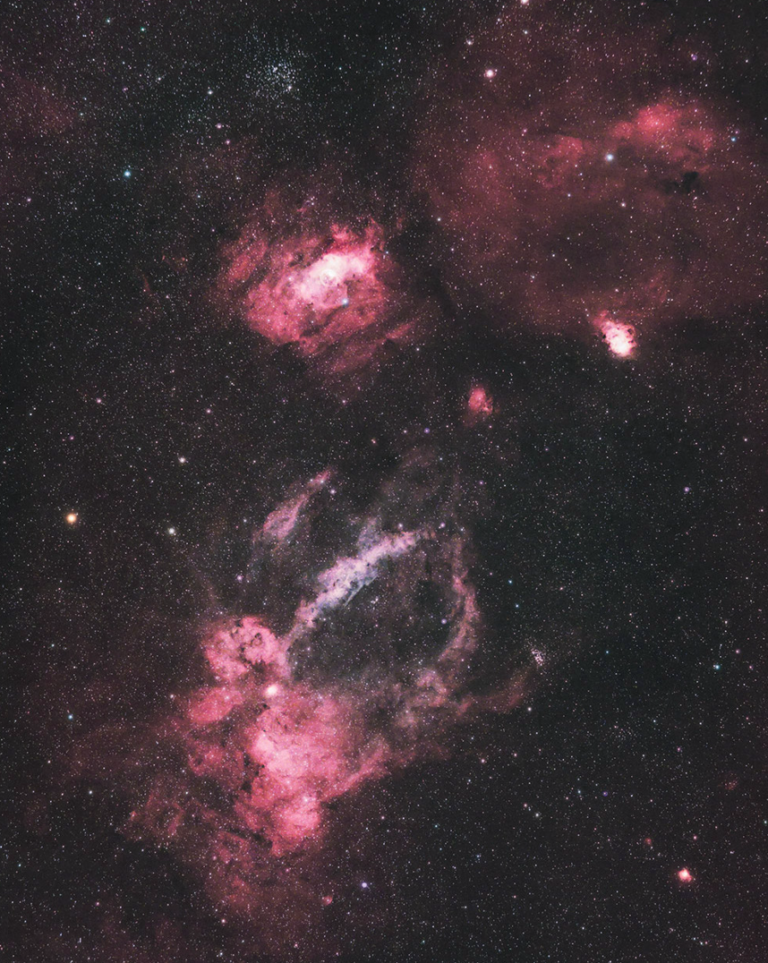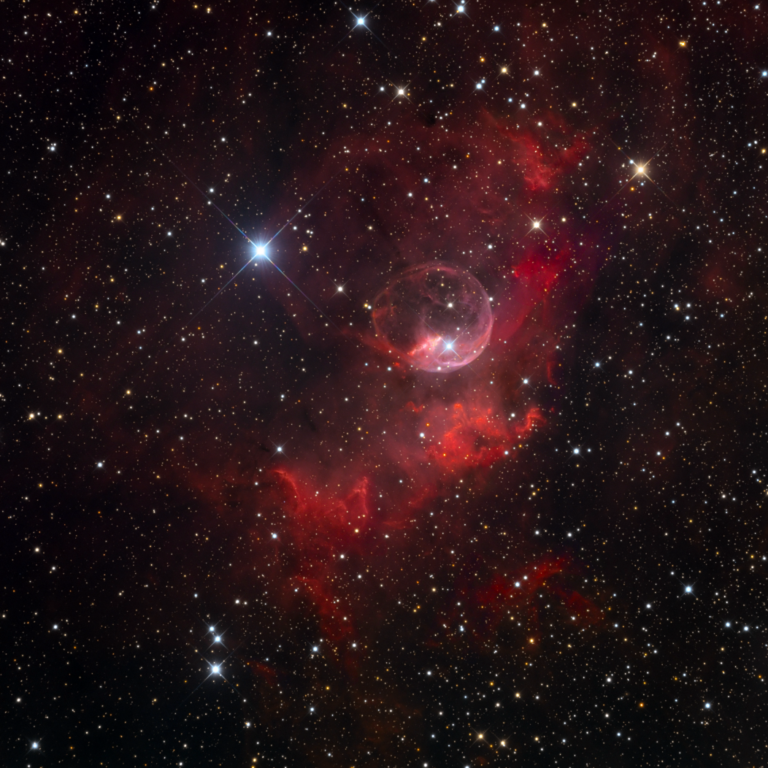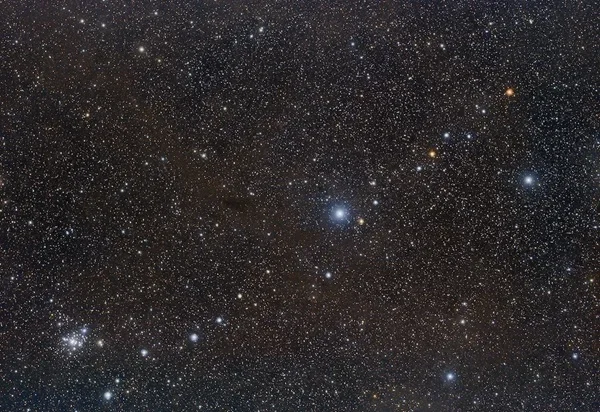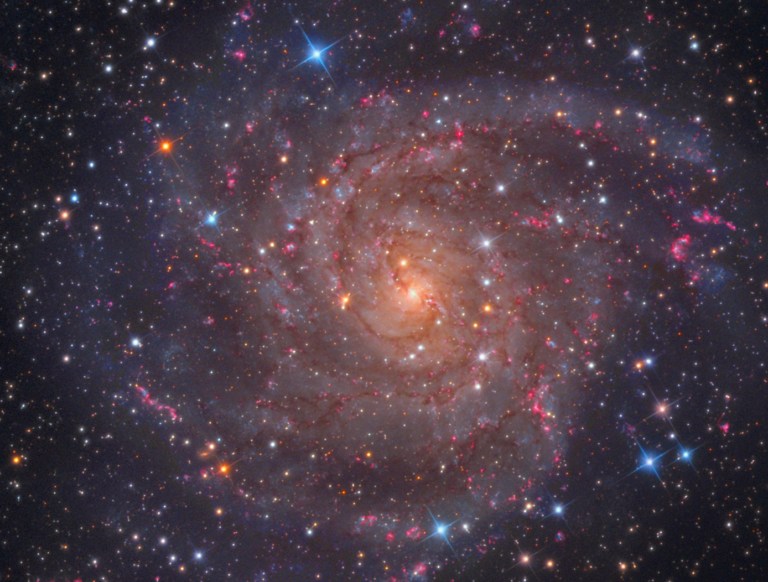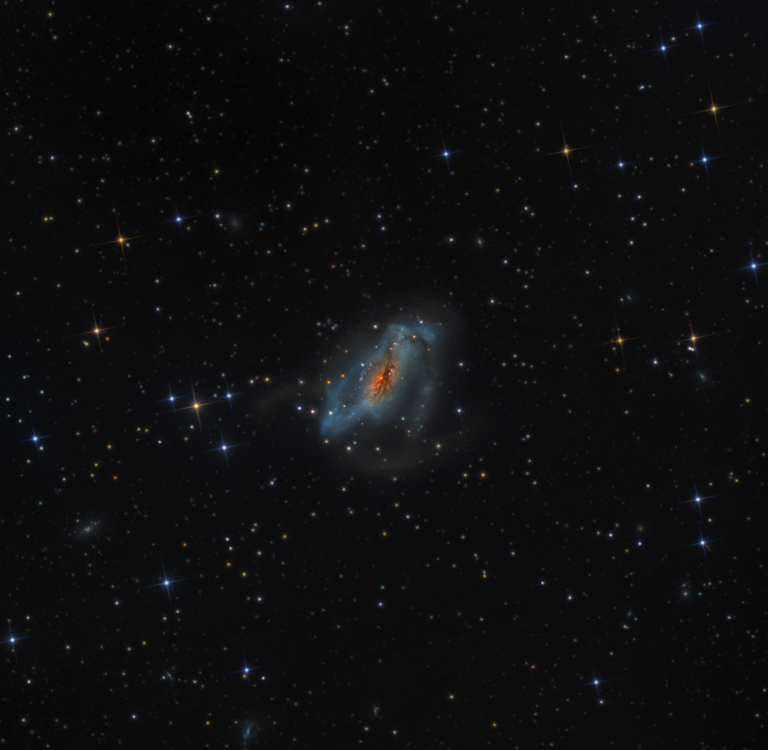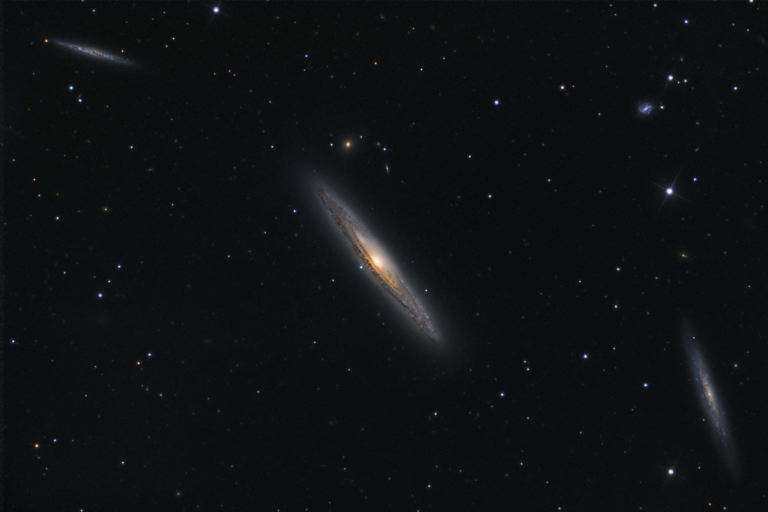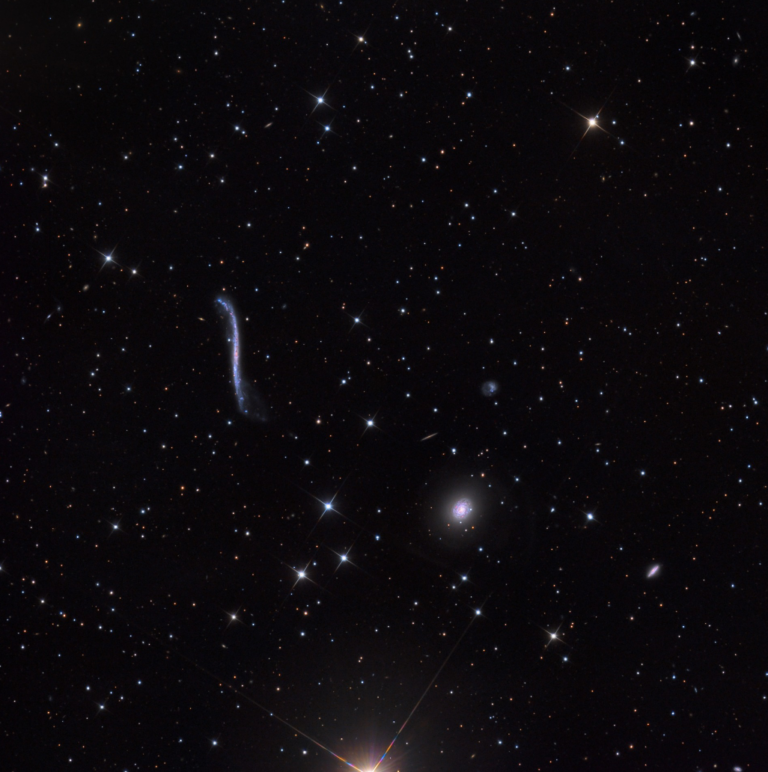What’s a large telescope? The notion of what’s big changes from observer to observer, but generally speaking, any scope of more than 10 inches’ aperture is still considered to be a big one. Although several of the following objects are easily visible in scopes smaller than 12 inches, Dave tailors his remarks about them with large scopes in mind.
The Little Dumbbell Nebula, also known as M76, presents a miniature version of the famous Dumbbell Nebula in Vulpecula. Located in Perseus, the Little Dumbbell is one of the more challenging Messier objects. Its twin lobes of nebulosity glow at 11th magnitude, making it a good target for large backyard scopes. Train a low power eyepiece a degree north-northwest of Phi Persei and you’ll se the double patch of hazy light.
If conditions permit, crank up the magnification to something like 25x per inch of aperture and you’ll get a fine sight. This expanding shell of gas lies about 1,800 light-years away and measures, as most planetaries do, about a light-year across.
The Eskimo Nebula (NGC 2392)
The brightest planetary nebula in Gemini is the Eskimo Nebula, NGC 2392. This 9th-magnitude object lies midway between Kappa and Lambda Geminorum. The object took on the nickname “Eskimo” because of its appearance — a mottled disk and faint outer ring resembling a “parka” — on long-exposure photographs.
With telescopes, the nebula’s small diameter of 40 arcseconds sometimes poses a problem for observers hunting with low powers. It appears as a tiny, out-of-focus star with a noticeable blue-green tint. Once you locate it, switch to higher magnification that will reveal the 10th magnitude central star surrounded by a fuzzy encircling disk.
Galaxy IC 10
Cassiopeia presents one of the winter sky’s great challenging galaxies. IC 10 is an irregular galaxy that lies on the outskirts of our Local Group. Although it’s close to home, IC 10 is difficult to observe because it’s intrinsically much fainter than most other galaxies and is heavily obscured by the surrounding rich Milky Way.
IC 10 is easy to find: simply move your telescope 2 degree east of Beta Cassiopeiae, the westernmost star in the “W” of Cassiopeia. Once you locate the galaxy’s position, switch to a low power eyepiece and look for a small “spot” of faint, milky light. In a large scope IC 10 appears as a round glow lying in a rich field of stars.
IC 342
The large, round barred spiral IC 342 is a treat in large telescopes. Once thought to be a member of the Local Group of galaxies, it is now known to be a close neighbor, a member of the IC 342/Maffei group. IC 342 is so heavily obscured by the thick Milky Way in front of it that it went undiscovered until 1890, when W. F. Denning found it. Only in 1934 did Edwin Hubble and Milton Humason find IC 342 to be a spiral galaxy.
You’ll need a large telescope to have a nice view of IC 342. The galaxy spans nearly 18 arcminutes across and is light is so spread out that it has a low surface brightness, so that individual parts of it appear dim. A 17.5-inch scope shows this galaxy as a bright, compact nucleus centered on a large halo of nebulosity with patchy striations suggesting spiral arms.
The Pleiades (M45)
The brilliant Pleiades star cluster, catalogued as M45, is familiar to all observers. The dipper-shaped star group in Taurus contains hundreds of stars and seems even brighter than the nearby Hyades because it is more condensed. The Pleiades comprises a young cluster of bluish-white stars; the brightest objects in the group are all B-type subgiants or main sequence stars. At a distance of about 400 light-years, or roughly three times that of the Hyades, the stars in the Pleiades are still close enough to provide a wealth of information to astronomers.
Since the Pleiades covers nearly two degrees of sky, you’ll need to sweep the area with a large scope to explore all the many fields, even at relatively low powers. On dark nights, a large scope will show faint reflection nebulosity surrounding several of the stars, particularly Merope. This is caused by extremely faint dust reflecting the starlight back to our line of sight. Some observers describe the delicacy of this light as “breath on a mirror.”
Open clusters M35 and NGC 2158
The most striking object in Gemini is the brilliant fifth-magnitude open cluster M35. This group of 120 stars measures one-half degree across, and its brightest members — B-type main sequence stars and G- and K-type giants — shine with 400 times the luminosity of the Sun. A good telescope trained on M35 reveals a field full of stars, many arranged in curves and rows, with a bright orange star near the center.
While you’re looking at M35, make sure you sweep around to see the cluster NGC 2158. The hazy group of light some 30 arcminutes southwest of M35 is another open cluster, this one five times more distant.
The Double Cluster (NGC 869 and NGC 884)
Even with the naked eye, a glance toward the constellation Perseus will reveal the Double Cluster, NGC 869 and NGC 884. Both clusters measure 35 arcminutes across; NGC 869 is the brighter at magnitude 4.4, while NGC 884 glows at magnitude 4.7. Even with a small telescope, the field of the Double Cluster appears peppered with two areas of bright blue and white stars, the brightest of which are 7th magnitude objects.
A large scope offers a spectacular opportunity for examining each of these clusters up close. A rich Milky Way field surrounds several hundred bright A- and B-type supergiants. A few dim red stars show up in and around the clusters — these are M-type supergiants.
Supernova remnant IC 443
The bright star Eta Genimorum hosts an oddity nearby, the supernova remnant IC 443. It’s esy to find, however. With your scope centered on Eta Gem, plop in a low-power eyepiece and swing your scope 1 degree northeast. If you’re observing in dark skies, you may just pick up the supernova remnant, a tenuous arc of gas 25 arcminutes long. This is a much fainter fersion of the Veil Nebula in Cygnus, and is probably not visible with anything less than a 12-inch scope on a night of good transparency.
The Crab Nebula (M1)
Taurus contains the sky’s best known example of a supernova remnant, the Crab Nebula, M1. The Crab, so named by Lord Rosse for its wispy filamentary structure, s the visible remains of a 1054 A.D. supernova documented by Chinese and Native American astronomers. Large scopes show the Crab as a large oval glow measuring some 8 arcminutes across with an irregular, oval shape, and punctuated by thin filaments of light that are eerily difficult to see. The Crab’s overall magnitude is about 9, making it relatively easy to see in large scopes.
The California Nebula (NGC 1499)
Target the bright star Xi Persei and you’ll be in the immediate vicinity of one of the great faint nebulae on the sky, the California Nebula in Perseus, also known as NGC 1499. In fact the star Xi is the illuminating beacon that causes the gas in the California to glow. Art 145 by 40 arcminutes, the California is one of the largest emission nebulae in the northern sky, although it’s not as easy to observe as the Orion, Lagoon, or even the Rosette Nebula.
The brightest parts of the nebula may glow around 14th magnitude; sky darkness and transparency dictate success with the California. In most locations it’s invisible with 6-inch and 10-inch scopes, but under superbly dark skies it’s visible in relatively small telescopes. Generally speaking, a large scope with the widest possible field of view should be used. A nebula filter seems to help greatly with spotting the edge of the nebula. If you see the California visually, congratulations — you are among a select group of observers.
Expand your observing at Astronomy.com
StarDome
Check out Astronomy.com’s interactive StarDome to see an accurate map of your sky. This tool will help you locate this week’s targets.
The Sky this Week
Get a daily digest of celestial events coming soon to a sky near you.
Observing Basics videos
Spend some time in our in-house observing expert’s “little corner of the universe.”



